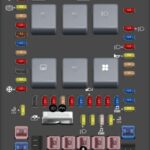This guide provides you with the essential steps to quickly use your Craftsman OBD2+ABS diagnostic tool. For comprehensive instructions and safety information, please download the complete Owner’s Manual from www.craftsman.com.
Retrieving Diagnostic Trouble Codes (DTCs)
To begin diagnosing your vehicle, follow these steps to retrieve trouble codes:
- Connect: Locate the diagnostic connector in your vehicle (usually under the dashboard on the driver’s side). Connect your Craftsman diagnostic tool to this connector.
- Ignition ON: Turn your vehicle’s ignition key to the “On” position. Do not start the engine.
- Automatic Link: The Craftsman OBD2 reader will automatically establish a link with your vehicle’s computer system.
Understanding and Viewing Diagnostic Results
Once connected, the tool will retrieve and display valuable diagnostic information:
- Stored Codes: These are the Diagnostic Trouble Codes (DTCs) that indicate detected issues within your vehicle’s systems.
- Freeze Frame Data: This data provides a snapshot of vehicle conditions when a DTC was set, helping to understand the context of the problem.
- System Status: LED indicators on the tool will display the overall status of your vehicle’s systems.
The retrieved information will be shown on the diagnostic tool’s screen.
- Navigating Multiple DTCs: If your vehicle has multiple DTCs, use the “DTC/FF” button to cycle through each code.
- Accessing Freeze Frame Data: After the Priority Code is displayed, pressing the “DTC/FF” button again will show the Freeze Frame Data, if available for that specific code.
- Viewing Long Code Definitions and Freeze Frame Details: For extended code definitions or when reviewing Freeze Frame Data, use the “UP” and “DOWN” buttons to scroll and view all the information presented on the screen.
Accessing OEM Enhanced Diagnostic Trouble Codes
For deeper diagnostics, your Craftsman tool can access OEM Enhanced DTCs, which include codes for systems like ABS (Anti-lock Braking System) and SRS (Supplemental Restraint System). This enhanced capability is available for many vehicles from manufacturers including:
- Chrysler/Jeep
- Ford/Mazda
- GM/Isuzu
- Honda/Acura
- Toyota/Lexus
To enter OEM Enhanced mode:
- Press the “SYSTEM” button on your tool. The System menu will appear on the screen.
Performing Additional Diagnostic Tests
Your Craftsman OBD2 reader is capable of conducting additional system tests to further pinpoint issues. To access these tests:
- Press the “M” button to access the Main Menu.
- Use the “UP” and “DOWN” buttons to navigate and highlight “System Tests”.
- Press the “ENTER” button to select “System Tests”. The System Test Menu will be displayed.
- Again, use the “UP” and “DOWN” buttons to highlight the specific test you want to perform:
- O2 Sensor Test
- OBD Monitor Test
- EVAP Test (Evaporative Emission System Test)
- Press “ENTER” to initiate the selected test.
These tests provide valuable insights into the functionality of specific vehicle components and systems.
Viewing Vehicle Information
To access and view vehicle-specific information stored in your car’s on-board computer:
- Press the “M” button to go to the Main Menu.
- Use the “UP” and “DOWN” buttons to highlight “Vehicle Info”.
- Press the “ENTER” button to select “Vehicle Info”.
This function allows you to retrieve important details about your vehicle directly from the diagnostic tool.
By following this quick guide and consulting your Craftsman Obd2 Code Reader Manual for detailed information, you can effectively diagnose and understand your vehicle’s health, saving time and potentially costly trips to the mechanic.
